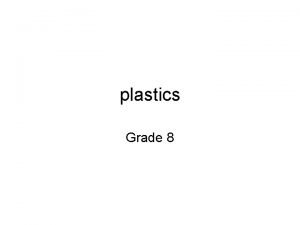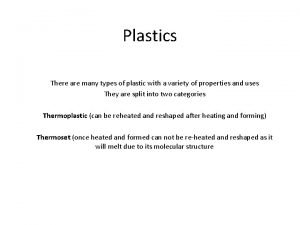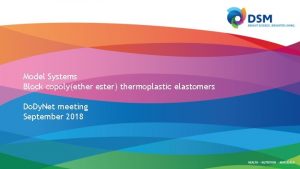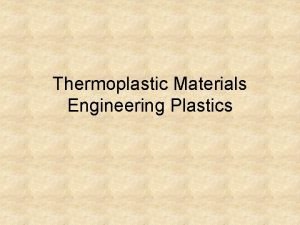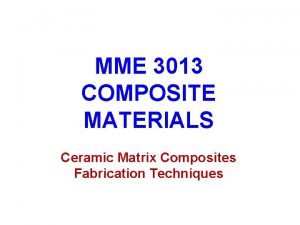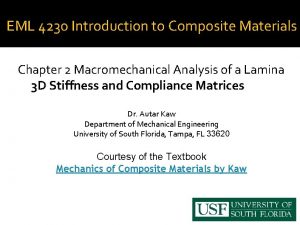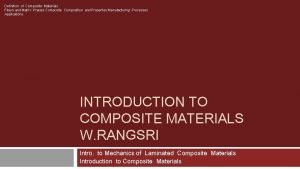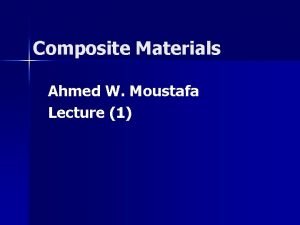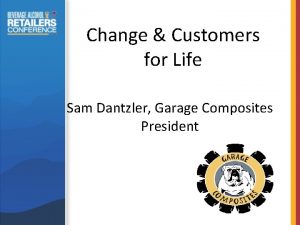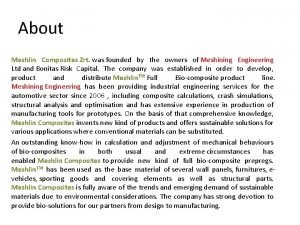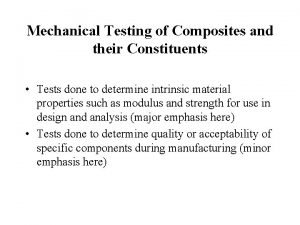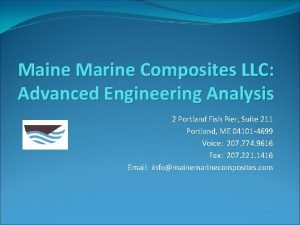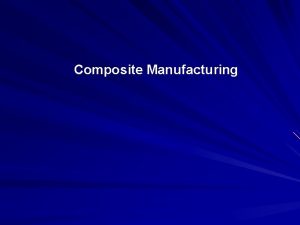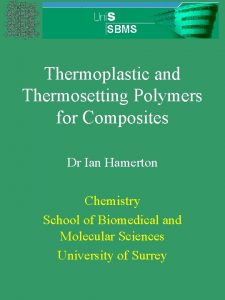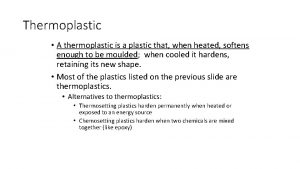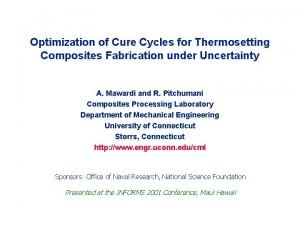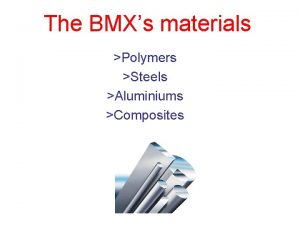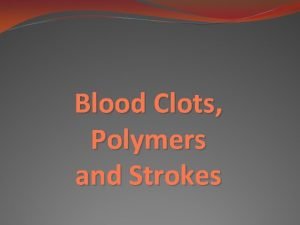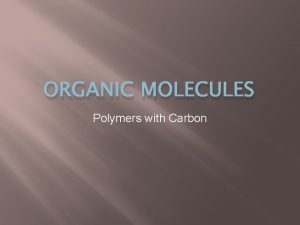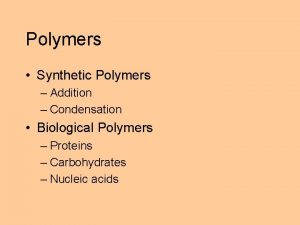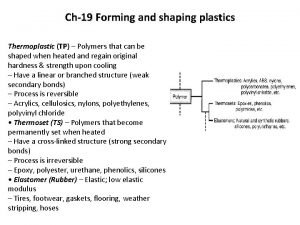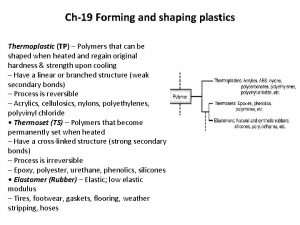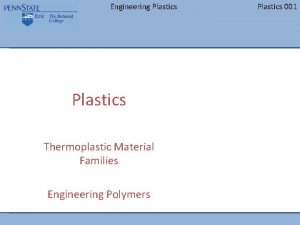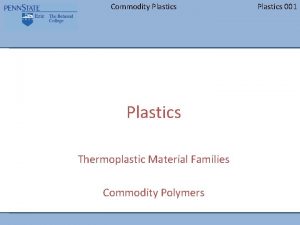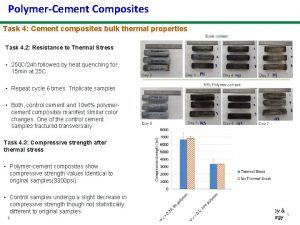Thermoplastic and Thermosetting Polymers for Composites Dr Ian
















- Slides: 16

Thermoplastic and Thermosetting Polymers for Composites Dr Ian Hamerton Chemistry School of Biomedical and Molecular Sciences University of Surrey

Outline of Presentation • • • Definition of a Composite Thermosetting polymers Thermoplastic processing Use of Composites in Aerospace Performance Criteria Application of LCA to composites Conclusions Questions 2

Composite A multi-phase material in which the properties of a continuous phase (matrix) are enhanced by distributed sheet-like, fibrous or particulate fillers 3

Common Thermoset Polymers Epoxy (common, industry standard, versatile) Vinyl esters (composition, cost properties between epoxies and unsaturated esters) Unsaturated polyesters (cheapest, good properties at lower temperature, large components/volume production) Phenolics (lower mechanical properties, retain to high temperature, no toxic flammables) Polyimides (expensive, but high performance) Bismaleimides (good hot/wet properties, brittle, cheaper than some polyimides) Cyanate esters (low loss properties, relatively expensive) 4

Selected high performance thermosets Polyimides Bismaleimides Cyanate esters Epoxy Vinyl polyesters Phenolics Unsaturated polyesters 5

Thermosetting Polymers Can offer • Variety of physical forms and viscosities • Wide choice of curing systems • Latitude with processing conditions • Low cure shrinkage • Good chemical resistance • Good mechanical properties • Good fibre/reinforcement adhesion • Thermal stability over wide temperature range • Good resistance to moisture But… • Often limited outlife • Usually need to be toughened • Pose significant recycling problems 6

Selected high performance thermoplastics 7

Thermoplastic Polymers • Will soften above Tg for shaping and harden in this form on cooling Can offer • Better resistance to moisture and various industrial solvents than thermosets • Superior flexural and impact properties to thermosets But… • Poorer abrasion and dimensional stability to thermosets • No apparent advantage in static properties or fatigue • Higher processing temperatures than most thermosets (generally above 300 o. C) • Compression strength may be inferior 8

Thermoplastic matrices Poly(amide-imide)a Polyarylethersa Tg/o. C 275 220 -260 Tproc/o. C 345 -355 310 -345 Polyethersulphonea 220 300 -310 Poly(arylene sulfide)a 200 -210 345 Polyetherketonec 140 -145 340 -350 Polyphenylenesulfidec 85 -95 330 Poly(arylene ketone)c 200 -210 370 -415 Polyimidea, c 350 -360 Tg = Glass transition temperature Tproc = Processing temperature 250 -280 a = amorphous c = crystalline 9

Thermoplastic processing methods • Autoclave consolidation • Press forming (rubber assisted punch or hydro forming) • Double diaphragm forming • Pultrusion • Roll forming • Filament and tape winding 10

Aerospace Applications • Combinations of thermoplastics and thermosets 11

Aerospace Applications 12

Trade offs as composite Property T/sets Formulations complex Melt viscosity very low Fibre impregnation easy Prepreg tack good Preprepg drape good Prepreg stability poor Processing cycle long Processing T/P low/moderate Fabrication cost high Mech. Properties fair to good (-54 to 93 o. C, hot/wet) Environ. Stability good Solvent resistance excellent Damage tolerance poor/good Database very large T/plastics simple high difficult none to fair excellent short to long high potent. low fair to good unknown poor to good fair/excellent small 13

LCA should address: • Initial preparation • Formulation • Processing • Lifetime(s) • Recycling potential 14

Conclusions – potential hotspots • Thermosets – High monomer cost – Long processing cycle – Storage of prepreg (refrigeration) – Repair (poor damage tolerance) – Poor recycling potential • Thermoplastics – High melt viscosity/impregnation – High polymerization temperatures 15

Any Questions? 16
 Thermoplastic polymers examples
Thermoplastic polymers examples How many types of plastic are there
How many types of plastic are there Ruler pencil sharpener
Ruler pencil sharpener Thermoplastic
Thermoplastic Thermoplastic
Thermoplastic John summerscales
John summerscales Composite and component knowledge ofsted
Composite and component knowledge ofsted Ceramic matrix composites definition
Ceramic matrix composites definition Isotropic material stiffness matrix
Isotropic material stiffness matrix Define composite in dentistry
Define composite in dentistry Ceramic matrix composites definition
Ceramic matrix composites definition Ceramic matrix composites definition
Ceramic matrix composites definition Sam dantzler
Sam dantzler Meshlin composites zrt
Meshlin composites zrt Mechanical materials
Mechanical materials Maine marine composites
Maine marine composites Composite manufacturing processes
Composite manufacturing processes
